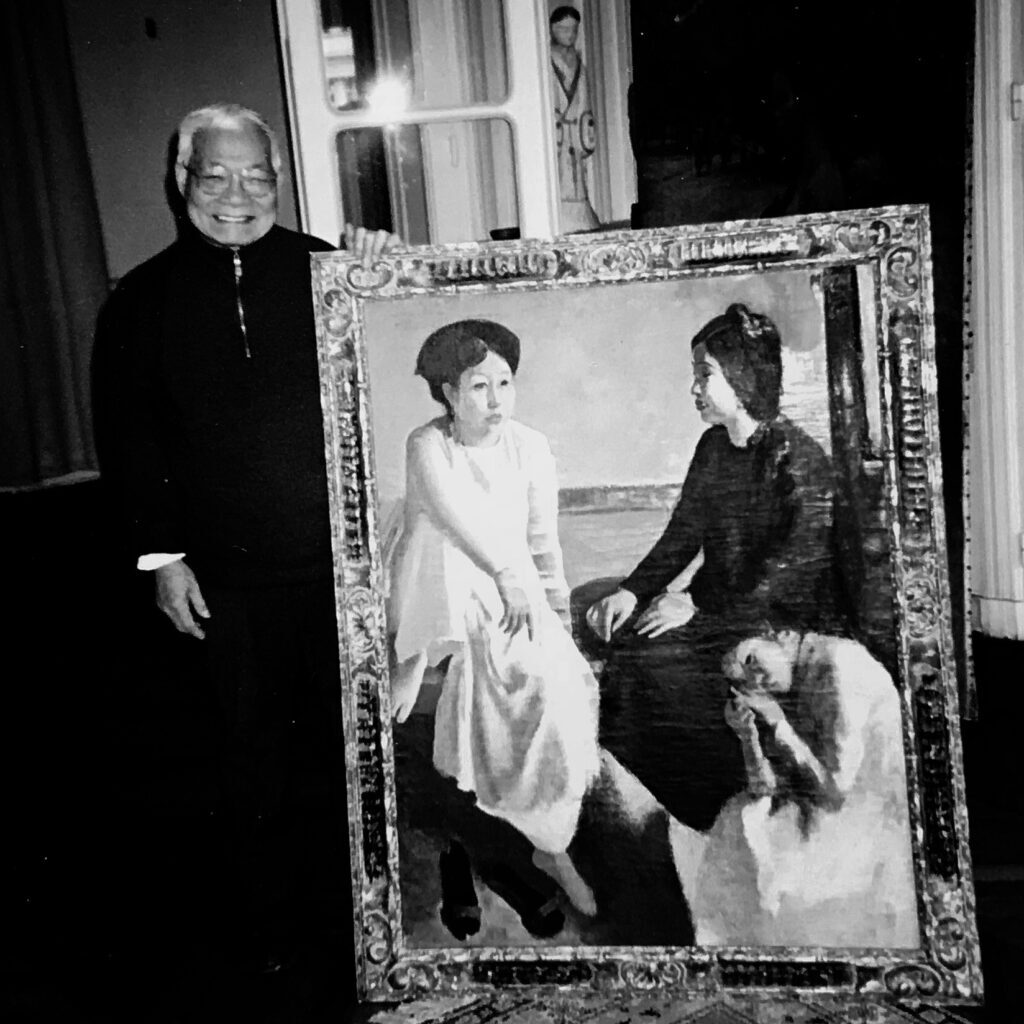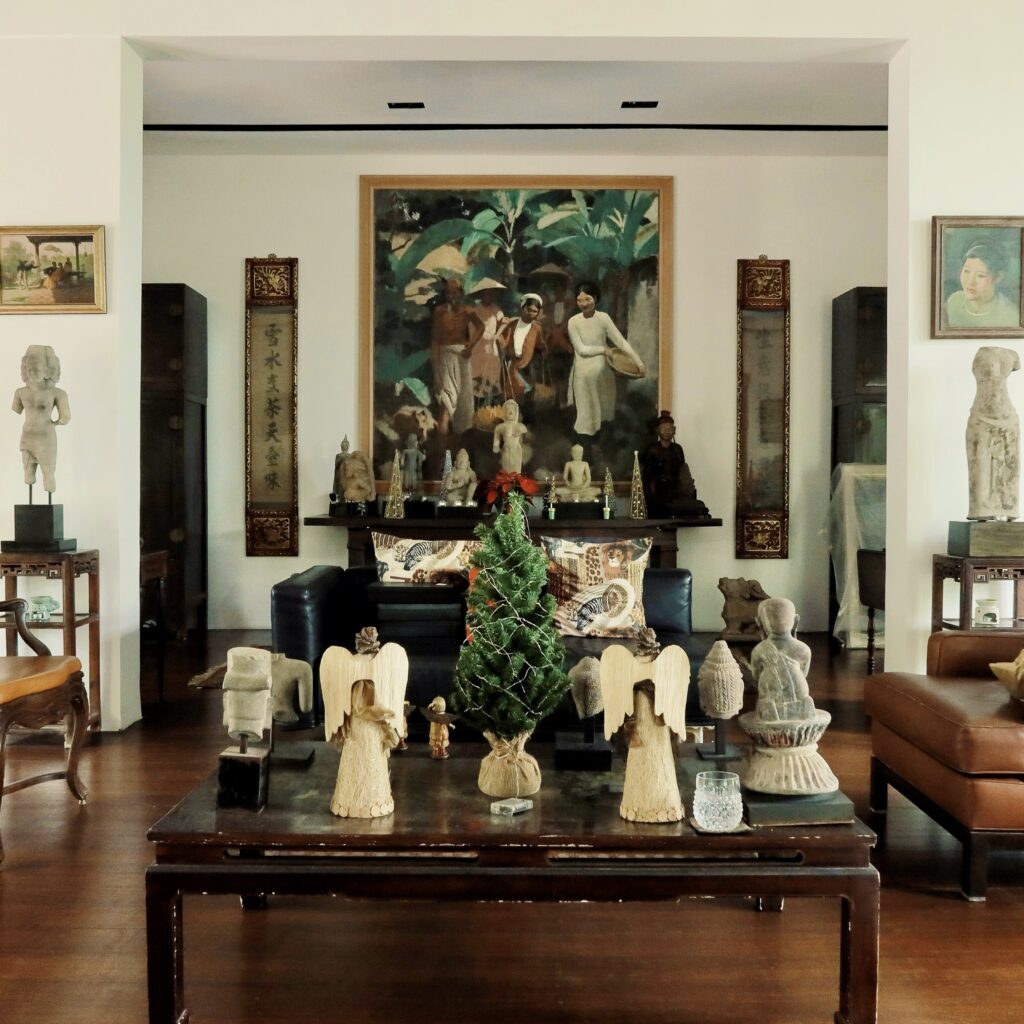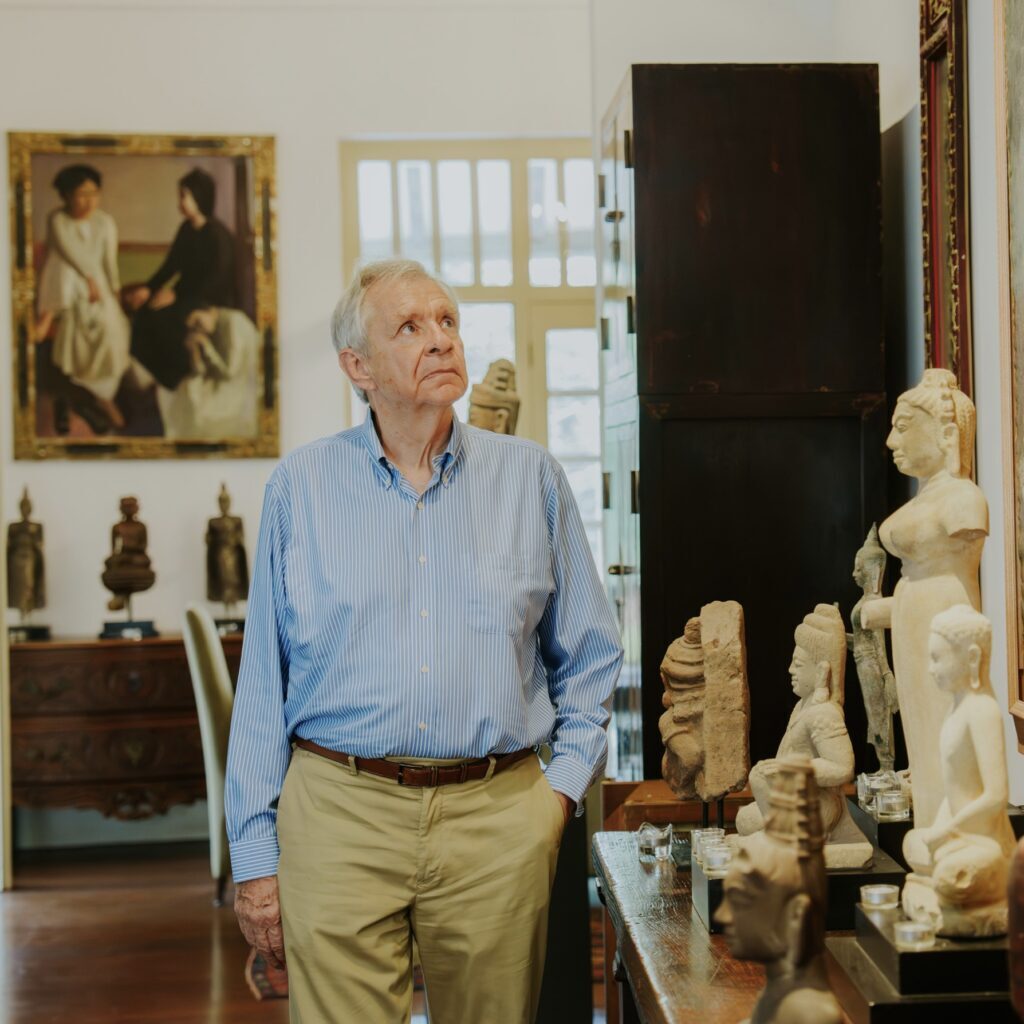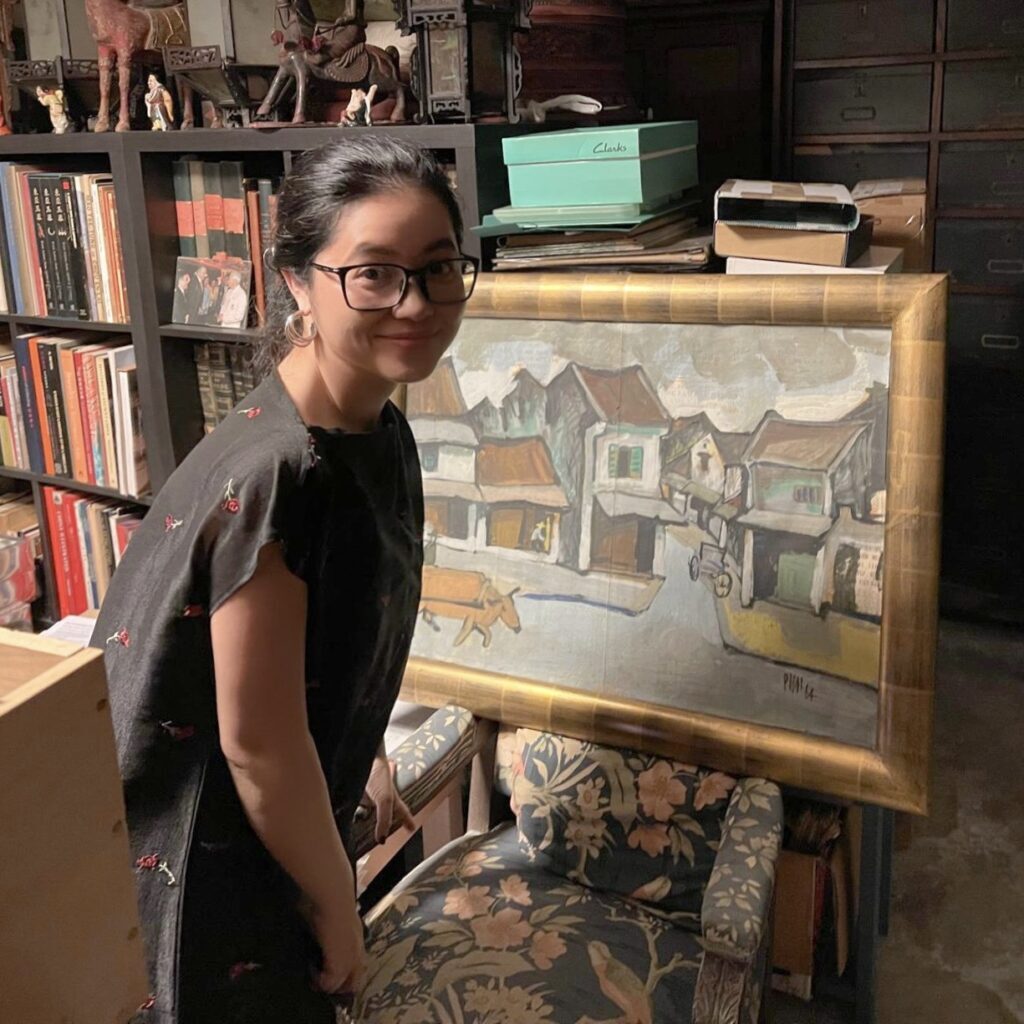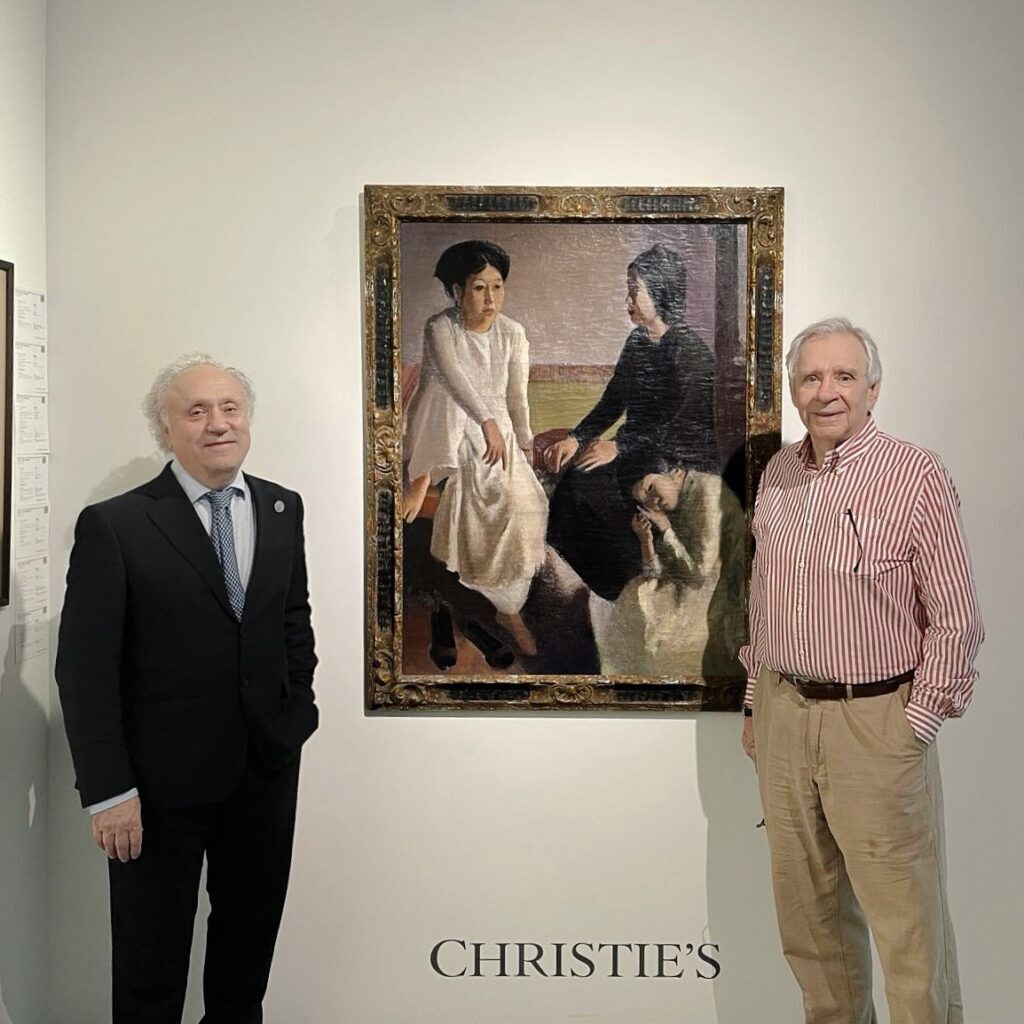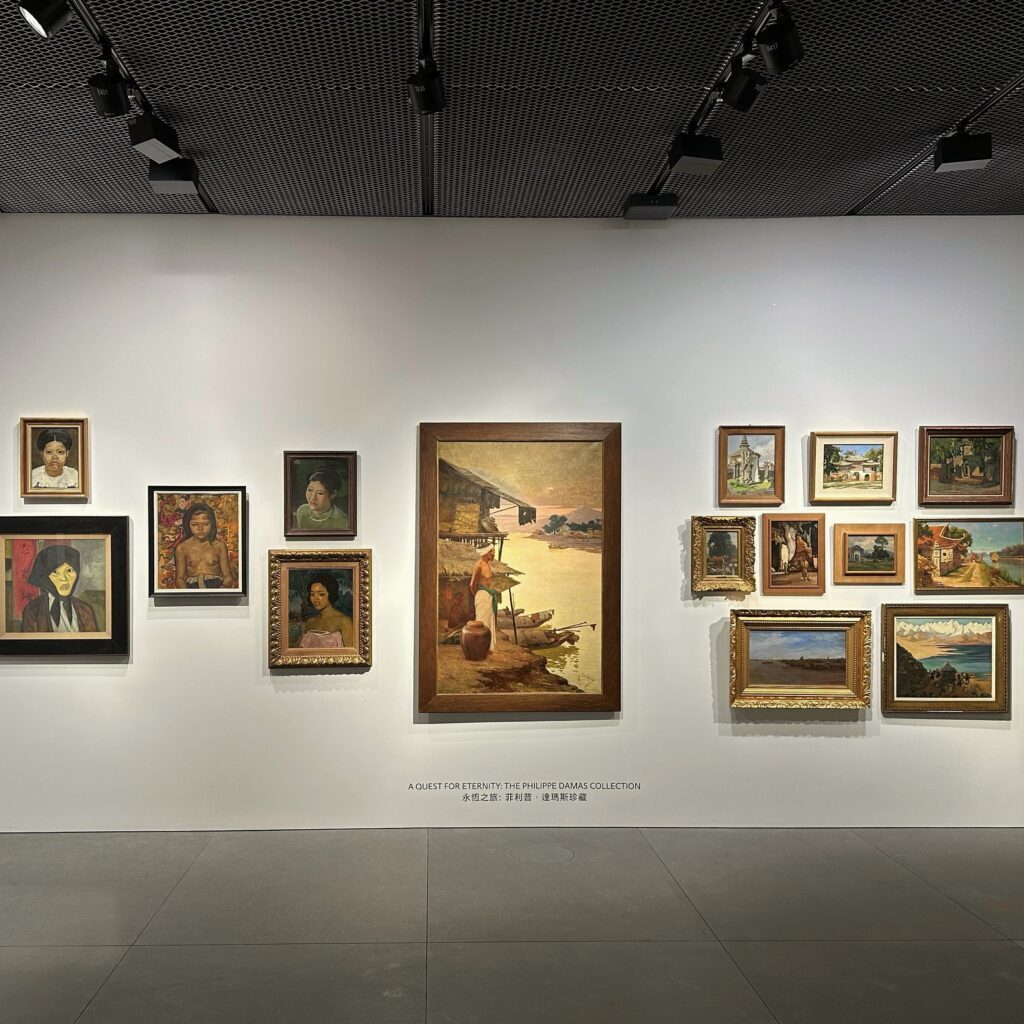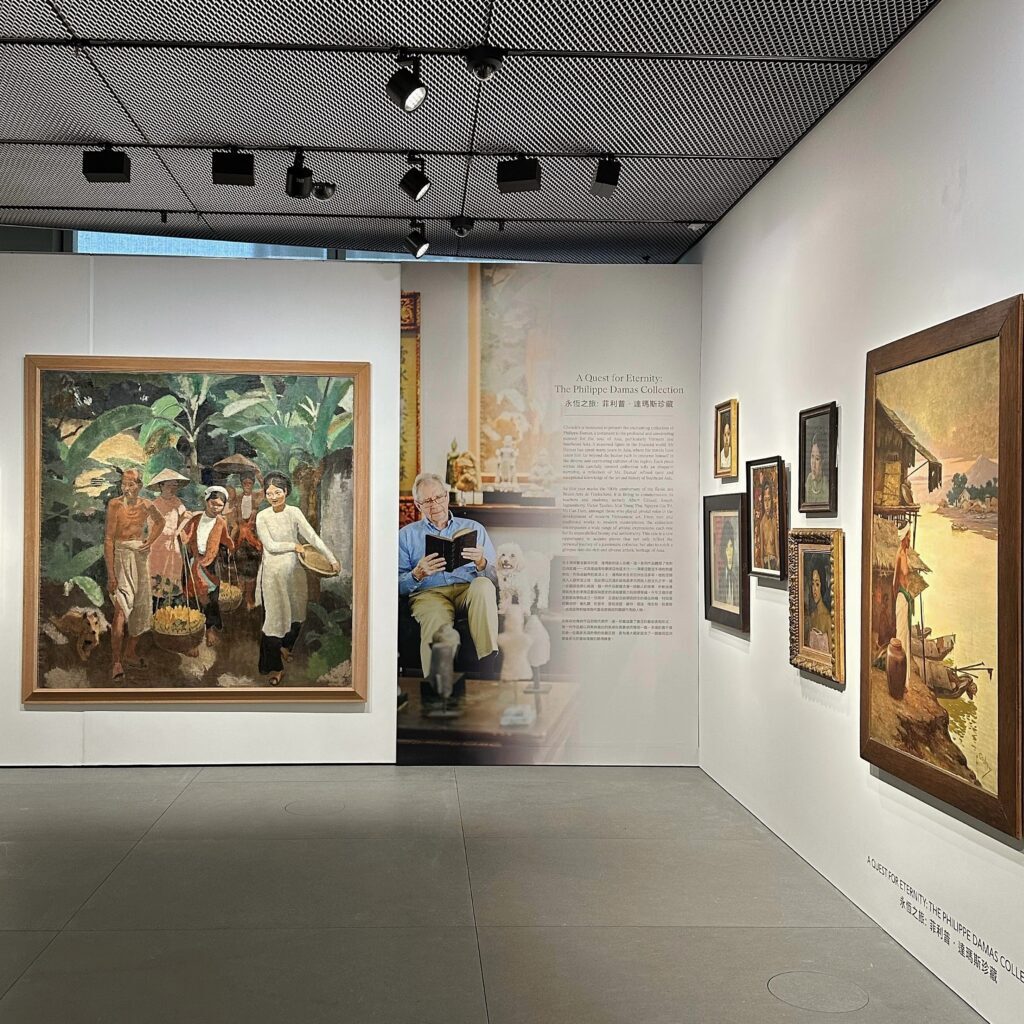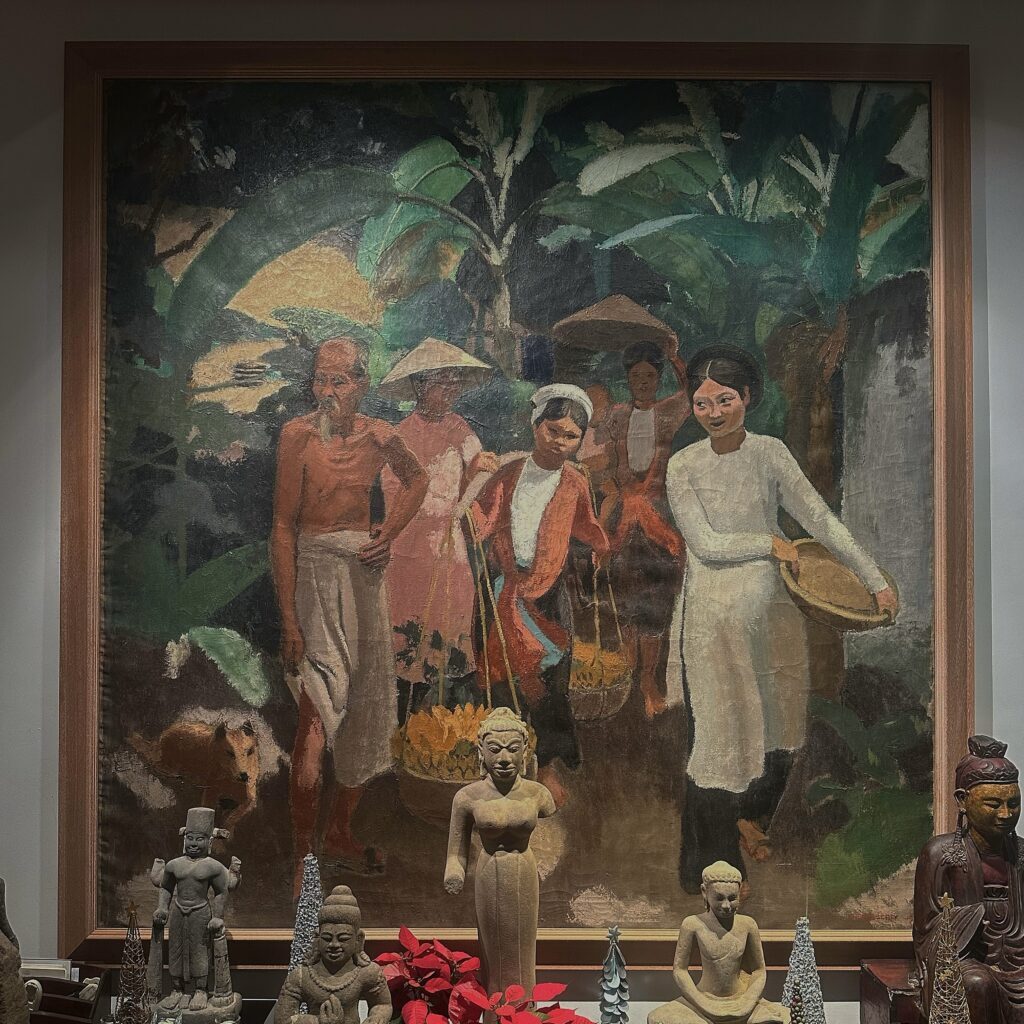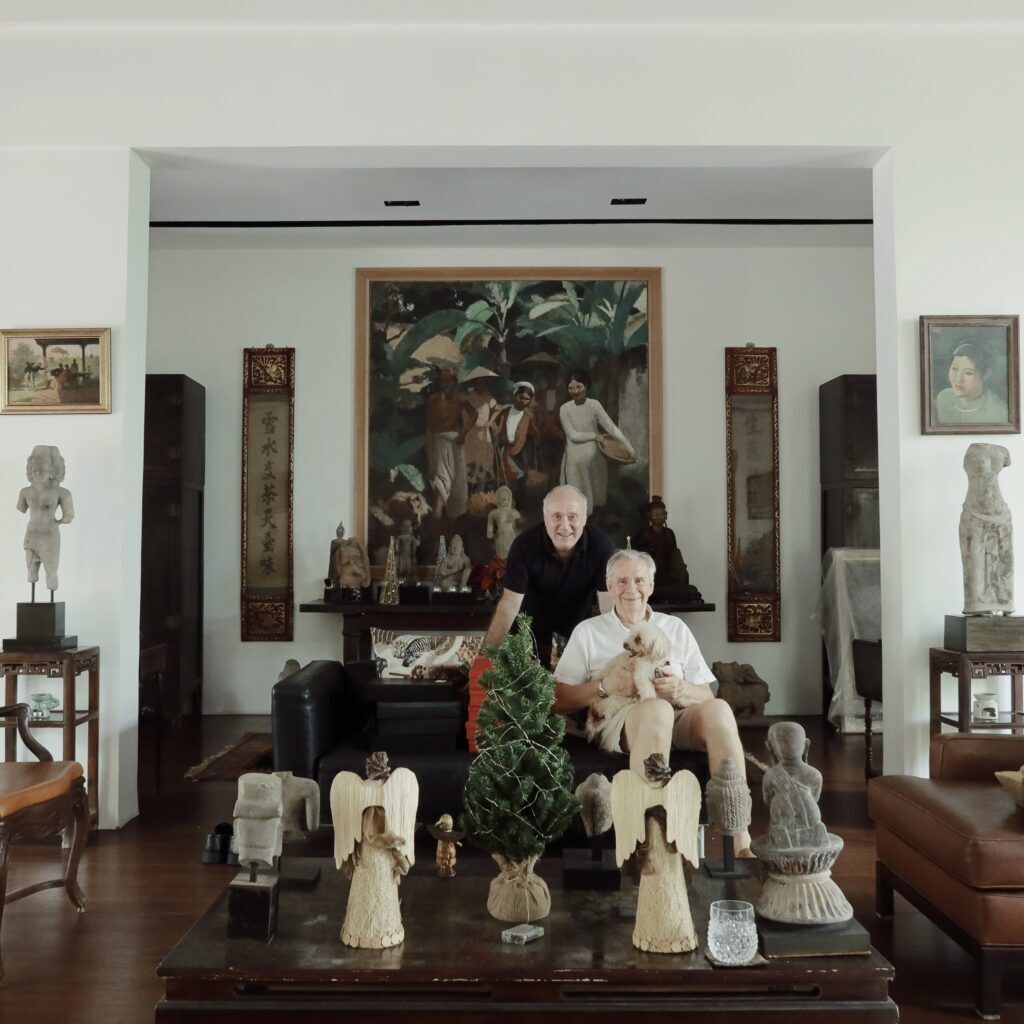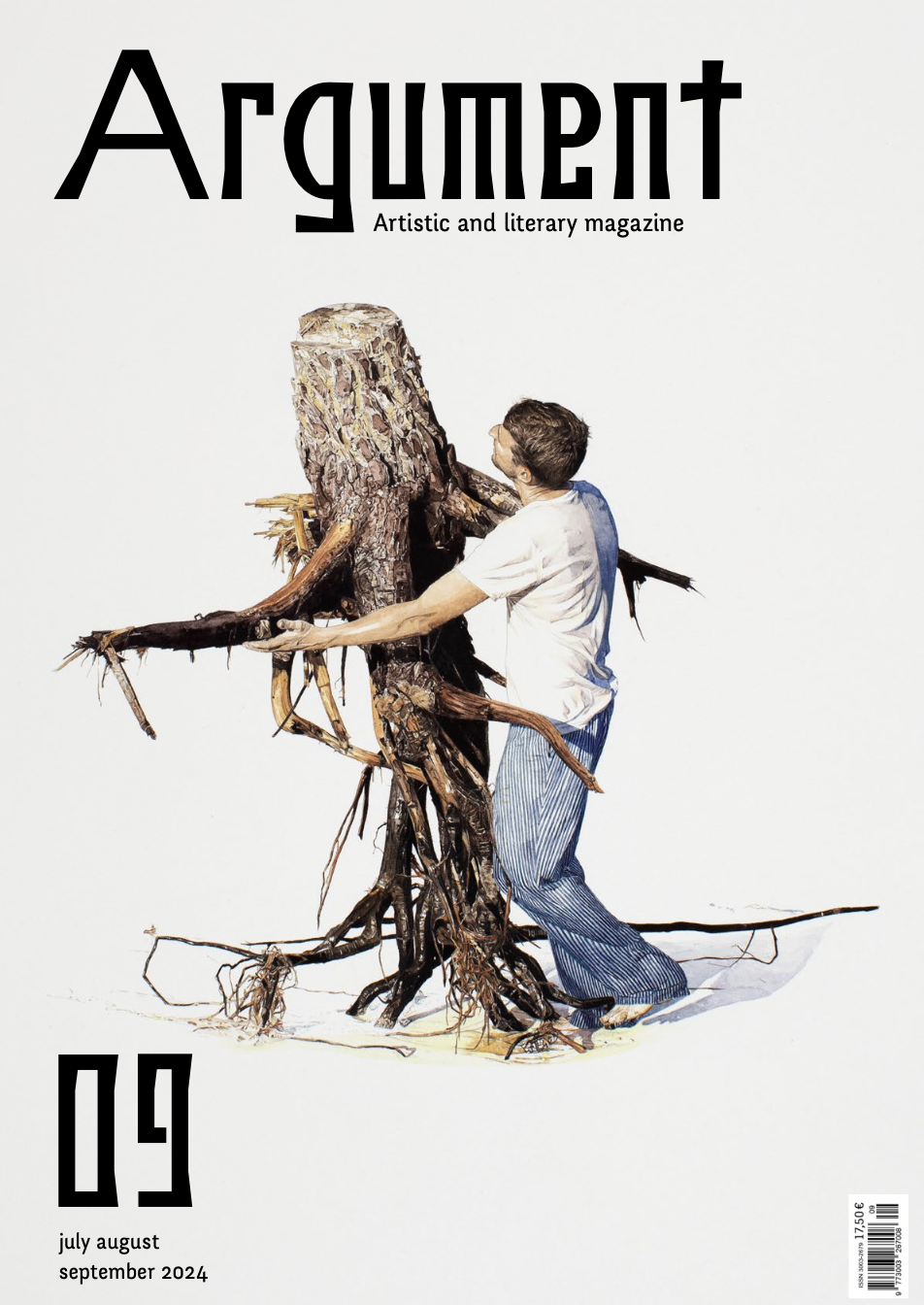
Argument Interviewing Vietnamese Art Expert Jean-François Hubert, published in July - September 2024.
One lucky day, while I was souring shion and euption and new talent. I came face to face with a very discreet personality who l've been following on social networks for decades.
Here is a portrait of Jean-Francois Hubert, the renowned expert in Vietnamese art.
Our friendship began with The Mandarin's Wife by the Vietnamese painter Le Pho. Can you share the story of this work with Argument readers?
This 'woman' came into my life in 1996. What a wonderful encounter!
That year, I had been an expert at Drouot for five years, promoting Vietnamese art in particular, first in general Asian art auctions, then by leading more specialised auctions, notably that of Prince Bao Long's collection the previous year. I also curated two major exhibitions at Le Bon Marché, "Vietnam of the Kingdoms" in 1995 and "The Soul of Vietnam" in 1996. One hundred thousand visitors in five weeks each time. Unprecedented for this type of event. The craze for Vietnamese art had begun.
One day, in the underground, a young man I knew by sight because he used to go to Drouot, approached me and told me that his parents owned an Asian work depicting a woman by the name of "Lê Phố". Stupidly, I was told that "there must also be flowers with this woman, and it must be an oil on canvas".
I then thought of one of the works from the painter's rather abundant Findlay period (from 1963).
The next day, still in the metro, the same young man who had been watching me patiently said to me: "It's an oil on canvas, there's a woman and flowers, but it's located and dated Hanoi, 1931". I practically grabbed this bearer of good news and off we went to his parents' house to see the painting, which was to become an icon for its artistic value, its history and its messianic role in the recognition of Vietnamese painting. The happy owners, who had bought it twenty-five years earlier from an auctioneer in Versailles, wanted to sell it. I told them that I could find them a buyer (there was only one Asian buyer at the time...) for 50,000 francs, but that I would advise them to put it up for auction, as I sensed something positive was going to happen. They agreed, and I always left - by metro - with the work, which I then took to Le Pho!
When you showed the work to Le Pho, what was his reaction?
The painting had no title. I called it The Mandarin's Wife, with the artist's support. Lê Pho told me the story: he had brought it with him from Vietnam in 1937, then, having volunteered for the French army (war had been declared against Germany), he had told his landlady to sell his belongings if the rent went unpaid. This she did, as the artist was demobilised and never found his painting.
This is how Lê Phổ, a little later, in a historic first, made the double cover of a sales catalogue at Drout, on 16 December
1996. You were there, dear Kim Chi, and you will remember the huge interest in the exhibition. However, the painting section was rivalled, in particular, by a prodigious group of Hué blues.
At 100,000 francs, there were still seven bidders with the same sensibility, but from different backgrounds, and the work was finally sold for more than three times its estimate, around 26,000 euros today, then later sold to another collector who recently sold it to the National Gallery of Singapore. But before that, in 2002, I had the pleasure of exhibiting it and publishing it again as co-curator of the exhibition "La Fleur du pêcher et l'oiseau d'azur, arts du Vietnam" - entirely devoted to Vietnam - at the Musée royal de Mariemont.
A long, beautiful and fundamental story.
Lê Phổ is Vietnamese, why is the poem in the top left-hand corner in Chinese characters?
Because it's an extract from Chinh phụ ngâm ("Song of the Combatant's Wife") written in Chinese (which all Vietnamese scholars were fluent in) around 1740 by Đặng Trần Côn (it was only later, at the end of the Xvill century or at the beginning of the XIX*, that Phan Huy ch transposed it into nôm).
The text reads:
"Seeking glory in the midst of a thousand sorrows,
Even though you're tired, you forget to rest.
Who can you confide the secret of your heart to?
Me, behind my door and you, on the horizon"
How much would La Femme du Mandarin be worth today?
Two million euros. And she would certainly do more.
You have been, and still are, an expert in Vietnamese art for well-known auction houses (Christie's, Sotheby's.)
How did Vietnamese art come to you?
First of all, a legal clarification: with these two prestigious houses, as with Drouot before them, I have always had independent status, and I like to think of myself as a 'liberal profession'. I have never in my life been an employee or a merchant, both of which are highly honourable statuses...
This independence means that my work has always been done "with", not "for", the prestigious institutions you mention. Independence is reciprocal, and so here, in our interview, as elsewhere, nothing I say reflects the particular opinion of each of these august institutions. They are not involved in any of my formulations.
Very early on, I was captivated by China, then Vietnam. Books, exhibitions, documentaries, public or private shows, trips: everything reinforced my taste. You have to fall in love at first sight to understand. I breathe better in Asia than in Europe.
You've worked alongside some famous Vietnamese painters. Can you give us an intimate portrait of an artist with whom you shared some rare moments?
I got to know Vũ Cao Đàm whom I often visited in Saint-Paul-de-Vence, but above all, among others, Jean Volang and Lê Phổ who lived on the same street (de Vaugirard, in Paris), close to where I live
I loved all these artists: noble, honest, caring, sentimental. I learned an enormous amount from them. A beautiful house for Vũ Cao Đàm, a charming studio for Jean Volang, a beautiful Haussmann flat for Lê Phổ. It was with him that I learned the most, because Volang, whom I liked very much, had little interest in the works of the alumni of the Hanoi School of Fine Arts, even though he was one of its former students. He did not graduate from the school, which closed after the Japanese coup of g March 1945. Vũ Cao Đàm lived far away. With Lê Phổ and the precious Paulette, his adored and adorable wife, it was the joy of getting to know each other in an extraordinary atmosphere. We would discuss the works, including those of other artists that I would bring him, calmly, at length. I took Phố and Paulette to Drouot. I would pick them up in my car and take them home. They told me a lot of things that I will never reveal. In terms of notoriety, Lê Phổ was at the bottom of the wave at the end of the 1980s. He trusted me and his career took off again. He was delighted with the exhibition at Le Bon Marché where his works featured, with the covers of the Drout and then Christie's catalogues, and with the news that the Singapore museum had bought the work on the cover in 1999 (even though no French museum would go near it...) I still remember his scrutinising eye, Paulette's protective pride and their happiness. Those were the years 1995-2000. Sparkling, fresh, enthusiastic.
In the very closed and selective world of major art collectors, you have the reputation of being a visionary. Your advice is reliable and has been confirmed over time. For beginners in Asian art in general and Vietnamese art in particular, what are the best values and artists to follow?
When it comes to painting, values are the expression of painters at their best: Lê Phổ and Mai-Thu from 1930 to 1945, Vũ Cao Đàm from 1930 to 1963, Nguyễn Phan Chánh from 1929 to 1939, just ten years, with an emphasis on 1929-1934, Nguyễn Gia Trí, Phạm Hậu when they don't wither in their repetitions;
Hoàng Tích Chù, Tô Ngọc Vân, but he produced little, Trần Bình Lộc, Lê Thị Lựu, also. Others are excellent, but are often only known for two or three works and therefore, in essence, not very collectible. Come on, a "tip" for your readers: Trân Quang Trân better known as Ngym, is an immense artist. Privately, his Saw euros, uhet i which rise intoned the around
Among the most recent, of different extraction, and to be followed: Nguyên Trung, Trương Bé, Bội Trân.
But for "newcomers", I would also advise broadening their vision to all facets of Vietnamese art: ceramics, the bronzes of Đông Sơn, the art of Champa or the Khmer art of the delta. They deserve more attention.
For twenty-five years, i was a financial director and an investment expert. in my experience, art investments are the most profitable. Would you confirm or deny that a collector could become a millionaire if he makes a good acquisition?
A millionaire? Not easy. But building and managing an exciting estate is.
Of course, we are no longer in the era when a Nguyên Phan Chánh from 1931 was worth the equivalent of 5,000 euros, whereas it is worth two hundred times more today. Gone, too, is the era of the "Hué blues" that Prince Bảo Long Long kept in his kitchen, preserving their real role as tableware, but there are still nuggets, periods, for painters, in other artistic fields.
Another example for your readers: the works of Vũ Cao Đàm when he lived in Vence, particularly from 1953 onwards. They remain under-priced, with collectors enthusiastic about his early works, or his Findlay period (1963-2000), whereas the artist testifies in his beautiful town of Vence to a joyful enthusiasm and a constant, breathtaking research.
In addition, the bronzes of Dông Son, the grandiose sculptures of Champa, the extraordinary ceramics of Bat Trang, breathtaking in their originality and not followers of Chinese art like the blues of Huê, the Buddhas of Oc-èo, are extraordinary leads.
As with paintings, the colonialists were the first to take an interest and bring some back to France. You can find them if you look hard enough.
I've just come back from a trip to Vietnam where i was able to talk to some rare collectors. Compared with France, where owners can have their works authenticated by experts, in Vietnam it's more complicated. it seems that 60% of works are fake. What's your opinion?
There are a few major collectors in Vietnam whose works are all authentic.
Some are a little ostentatious, but the most extraordinary collection belongs to a binational who carefully hides his trea-sures. He made his first purchase in 2005, on my advice. Since then, he has amassed a treasure trove. He's rather distant, but always smiles a little when we bump into each other, especially when, five metres away, a 'collector' is filming himself live - for his Facebook 'network' - next to a painting he'll never buy and whose artist's name he misspells..
Alongside the real collectors, there is a whole, rather nauseating group of interlopers who dream of entering the market.
They have no knowledge, are bitter, aggressive and spew their bile on the Internet.
The real problem is that Vietnam is one of the five remaining communist countries and "socialist realism" is a fact of life there: ideologically, art should be close to the people, bear witness to their daily experiences, highlight their courage during the "liberation" war and praise all the achievements of reconstruction.
The artist must be the servant of the socialist cause. The imposed themes were men and women, heroes, soldiers, peasants and "workers". It is easy to see how this could be detrimental to artistic expression and, above all, why the State did not see itself as the guarantor of art. Authenticity is therefore not a moral criterion... Fakes are everywhere, including in museums, and well-organised specialist teams quickly realised that France was the dream destination. Unrestrained entry into France, with local accomplices, a lack of knowledge on the part of players often attracted simply by the promise of a quick profit, customs and tax fraud, and the effective intermediaries provided by certain individuals in the Asian community are all detrimental to the market. This is obvious. And it's distressing.
On Linkedin, your fan club exceeds twenty thousand members. They all enjoy your art articles, such as the bestseller "Les Bons, les Brutes et les Truands", like a delicious ice cream in the sunshine. Without a doubt, your blog jeanfrancoishubert.com is the benchmark for Vietnamese art. Tell us about this success story.
I like LinkedIn because I learn a lot there: different sensibilities, different themes. Not just art.
My blog, in French and English, aims to raise awareness of modern Vietnamese painting (and sculpture). It's a format that's certainly demanding, but I like it because it's different from books, exhibition catalogues, films or articles, all of which have their own constraints, particularly those relating to the audience. Blogging gives me greater freedom of expression.
I choose the work, try to situate it, explain its technique and context, and sometimes write lengthy notes. I hate compro-mise, so some of my articles are quite offensive. In this world of cowards, racists and revisionists, you shouldn't hesitate to hit hard. I'm amazed at the passivity of my fellow citizens in all matters. An invitation to a cocktail party (usually funded by our taxes) is enough to turn some of them into supporters.
The blog, free of charge of course, with no advertising or other offers, is a suggestion on the Internet, a suggested, free walk.
No one is supposed to enter it unless of their own free will. I am amused to note that it is often used in notices, particularly of auctions. Sweet plagiarism...
As for the article you mentioned: "Les Bons, les Brutes et les Truands" (The Good, the Bad and the Ugly), which has had a huge impact, l've had a lot of positive comments about it. Like a breath of fresh air in a stale world. With unexpected results.
One of the people mentioned, who thought he had identified his initials, escaped to Vietnam. Poor Mekong delta... On a more serious note, it seems to have seriously curbed some of the trafficking and made the infiltration more... visible. A start, I hope.

